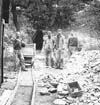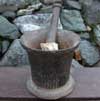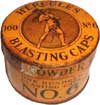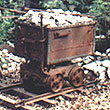|

Wildcat Mines of the Mother Lode and the Sierras:
Long after the California gold rush was over there were still
prospectors out in the hills trying to find the "big strike" that
would make them rich. Most of the surface gold and placer deposits
were worked out, so the only way to find gold was to dig down into
hard rock following veins of quartz. Hard rock mining was very expensive and much labor was needed to dig
the shafts, so most successful mining operations were conducted by
large companies that could raise capital and hire many workers.
 Young,
adventurous miners knew that you couldn’t get rich working in the big
mines, so they struck out on their own. Working on a
“shoestring”, these industrious but cash strapped men cobbled together
simple, homemade and often discarded tools to work the mines.
They formed small partnerships and worked as a team, hoping to share
the profit when they “struck it rich.” They had no “articles of
incorporation” and often didn’t even own the land they were working.
Many worked claims abandoned Young,
adventurous miners knew that you couldn’t get rich working in the big
mines, so they struck out on their own. Working on a
“shoestring”, these industrious but cash strapped men cobbled together
simple, homemade and often discarded tools to work the mines.
They formed small partnerships and worked as a team, hoping to share
the profit when they “struck it rich.” They had no “articles of
incorporation” and often didn’t even own the land they were working.
Many worked claims abandoned
 by
bigger companies, or old mines that had played out. Webster’s
dictionary defines the term “wildcat” as “any business or procedure or
the like considered outside the bounds of legitimate practice”.
Thus they became known as “Wildcat Miners” and their diggings as
“Wildcat Mines”. by
bigger companies, or old mines that had played out. Webster’s
dictionary defines the term “wildcat” as “any business or procedure or
the like considered outside the bounds of legitimate practice”.
Thus they became known as “Wildcat Miners” and their diggings as
“Wildcat Mines”.
A Typical
Wildcat Mine
 All over the
Mother lode and the Sierra
mountains, along roads or “back in the brush” one can find abandoned
shafts and holes. They don’t seem to go into the earth very far, and
there are no signs of buildings, head frames or industrial equipment in
the area. These holes are all that is left of a wildcat mine. The
typical wildcat operation was worked by two to six men. (more than
that and the fighting broke out!) If two men worked All over the
Mother lode and the Sierra
mountains, along roads or “back in the brush” one can find abandoned
shafts and holes. They don’t seem to go into the earth very far, and
there are no signs of buildings, head frames or industrial equipment in
the area. These holes are all that is left of a wildcat mine. The
typical wildcat operation was worked by two to six men. (more than
that and the fighting broke out!) If two men worked the mine, one man
worked inside the mine and the other ran the winch or worked outside.
Old miners used the term “two-man-mine” as a somewhat derogatory
description of a very small, unprofitable venture. The shafts—either
vertical or horizontal—followed a vein of quartz found at the
surface. Cribbing or supports in the shaft were minimal and often
consisted of chunks of trees and old used timbers from other mines.
Needless to say, with only a few men working at the site, they didn’t
want to waste valuable time and effort shoring up the shaft when they
could be digging for the big strike! Because the shafts were not
shored up very well, most of them have now caved the mine, one man
worked inside the mine and the other ran the winch or worked outside.
Old miners used the term “two-man-mine” as a somewhat derogatory
description of a very small, unprofitable venture. The shafts—either
vertical or horizontal—followed a vein of quartz found at the
surface. Cribbing or supports in the shaft were minimal and often
consisted of chunks of trees and old used timbers from other mines.
Needless to say, with only a few men working at the site, they didn’t
want to waste valuable time and effort shoring up the shaft when they
could be digging for the big strike! Because the shafts were not
shored up very well, most of them have now caved
 in.
The miners often lived in tents and homemade shacks around the mine.
They had very few possessions, and lived off of beans and hunted meat. in.
The miners often lived in tents and homemade shacks around the mine.
They had very few possessions, and lived off of beans and hunted meat.
Most of the time, the quartz played out after a
few hundred feet, or the miners never found enough gold to pay the
bills, or they got sick or injured. Whatever the reason, the
disillusioned wildcatters eventually gave up and moved on, leaving
pile s of tin cans, a few old bottles and a lot of broken down
equipment behind. All this old junk has now become the “historical
collectibles” that people residing in the Mother lode reverently
display in their backyards and even living-rooms. s of tin cans, a few old bottles and a lot of broken down
equipment behind. All this old junk has now become the “historical
collectibles” that people residing in the Mother lode reverently
display in their backyards and even living-rooms.
Equipment Used By Wildcat
Miners
We see many pictures of old mines with giant
steel head frames, monster size cable drum hoists, many buildings
containing rows of big stamp mills and other ore processing equipment.
These were deep, rich and successful mines run by corporations that
sold stock and hired hundreds of workers. But that is another story.
 Since the wildcat miners worked on a
“shoestring,” their equipment was simple and inexpensive. Also, they
had very little heavy industrial equipment, because there was great
cost and effort in transporting and setting up these pieces at the
mine. Much of the equipment was homemade, often made out of wood and
timber found around the mine. The wildcat miners usually had only one
used and often repaired ore car, a small homemade winch, and, if they
we Since the wildcat miners worked on a
“shoestring,” their equipment was simple and inexpensive. Also, they
had very little heavy industrial equipment, because there was great
cost and effort in transporting and setting up these pieces at the
mine. Much of the equipment was homemade, often made out of wood and
timber found around the mine. The wildcat miners usually had only one
used and often repaired ore car, a small homemade winch, and, if they
we re lucky, a few sections of narrow gauge iron track. If they
couldn’t afford the iron track, they made it out of wood! If the mine
was a vertical shaft, they built a small head frame with a cable wheel
and the winch ran an ore bucket down into the mine. If the mine was
successful enough to go fairly deep, then they added a water pump and
an air compressor. Most often the tools used for digging were simply
picks, shovels, rock drill shafts and sledgehammers. Air operated
rock drills were expensive! re lucky, a few sections of narrow gauge iron track. If they
couldn’t afford the iron track, they made it out of wood! If the mine
was a vertical shaft, they built a small head frame with a cable wheel
and the winch ran an ore bucket down into the mine. If the mine was
successful enough to go fairly deep, then they added a water pump and
an air compressor. Most often the tools used for digging were simply
picks, shovels, rock drill shafts and sledgehammers. Air operated
rock drills were expensive!
 The most effective tool used by wildcat miners
was dynamite! Many a small mining operation ended suddenly, however,
when blasting caved in the shaft and the miner setting the charge
never came out. Most of the rock dug out of the mine was tailings or
“muck”. It was loaded into the ore car and dumped out near the mine.
One can usually gauge the depth of the hole by looking at the tailings
pile next to the adit or entrance. The most effective tool used by wildcat miners
was dynamite! Many a small mining operation ended suddenly, however,
when blasting caved in the shaft and the miner setting the charge
never came out. Most of the rock dug out of the mine was tailings or
“muck”. It was loaded into the ore car and dumped out near the mine.
One can usually gauge the depth of the hole by looking at the tailings
pile next to the adit or entrance.
When gold ore was brought out, it had to be
crushed and worked. Some miners could afford small portable crushers
or stamp mills made commercially, but most used small grinders called mullers and washed the slurry in cradles or even pans. In the final
analysis then, most of the equipment used by wildcat miners had to be
small and light enough to be transported on a wagon or mule, since the
mines gave out quickly and the equipment had to be moved to a new
prospect often. In most operations, the biggest and most bulky item
used was the ore car or ore bucket. Luckily for the collectors of
today, when the mines gave out, these were often left behind by tired
and broke miners that finally gave up their dream. miners could afford small portable crushers
or stamp mills made commercially, but most used small grinders called mullers and washed the slurry in cradles or even pans. In the final
analysis then, most of the equipment used by wildcat miners had to be
small and light enough to be transported on a wagon or mule, since the
mines gave out quickly and the equipment had to be moved to a new
prospect often. In most operations, the biggest and most bulky item
used was the ore car or ore bucket. Luckily for the collectors of
today, when the mines gave out, these were often left behind by tired
and broke miners that finally gave up their dream.
|


Like to tell me of
something you have?
If you have an
interesting ore car, or other items from 1849 to the early 1900's you think
might have been used in mining, or perhaps some bits of history,
documents or photos, that
you are willing to share, let me know:
Click
Here
|











